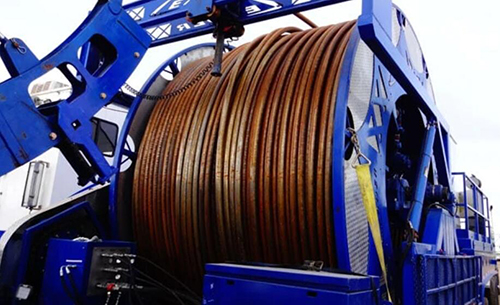What is the difference between coiled tubing and wireline?
Coiled tubing and wireline are two distinct methods used in the oil and gas industry for well intervention and various well-related operations. While they both serve similar purposes, they have fundamental differences in terms of their equipment, applications, and operational characteristics:
Equipment:
Coiled Tubing: Coiled tubing is a continuous, flexible metal tube wound on a large spool. It is typically made of steel and can range in diameter. Coiled tubing units are equipped with a control cabin and a hydraulic injector that spools the tubing into the wellbore.
Wireline: Wireline, on the other hand, consists of a single steel or braided cable that is used to lower tools and instruments into the well. The tools and equipment are attached to the wireline and are lowered or raised by winching the cable in and out of the well.
Applications:
Coiled Tubing: Coiled tubing is often used for various well intervention and production enhancement operations, such as cleanouts, acidizing, cementing, and wellbore cleanouts. It is particularly useful for operations that require the circulation of fluids or the deployment of tools over long lengths.
Wireline: Wireline is primarily used for logging and data acquisition purposes. It is used to lower down tools like logging tools, sensors, and cameras to gather information about the well's conditions, including pressure, temperature, and rock formations. Wireline is also used for perforating and setting plugs.

Capabilities:
Coiled Tubing: Coiled tubing can circulate fluids and perform various mechanical operations due to its continuous tubing design. It can also reach greater depths and provide a means for pumping fluids into or out of the well.
Wireline: Wireline excels in data collection and logging. It can reach significant depths in a wellbore but is primarily focused on well evaluation and monitoring rather than mechanical interventions.
Deployment:
Coiled Tubing: Coiled tubing is deployed by spooling it off the reel into the wellbore. It is continuously fed into the well, making it suitable for operations that require long, continuous access to the wellbore.
Wireline: Wireline is deployed by winching it in and out of the wellbore. It is a more versatile option for logging and data collection as it allows tools to be lowered to specific depths and retrieved without pulling the entire length of cable.
In summary, coiled tubing is more suited for mechanical interventions and operations that involve fluids, while wireline is primarily used for well logging and data acquisition. The choice between these methods depends on the specific objectives of the well operation and the characteristics of the wellbore. Often, both coiled tubing and wireline services may be used in conjunction to achieve different goals in a single well intervention project.
Previous: >> What is Schedule 40 pipe 304? Next: >> Stainless Steel Tubing Coils: Symbol of Durability and Versatility






